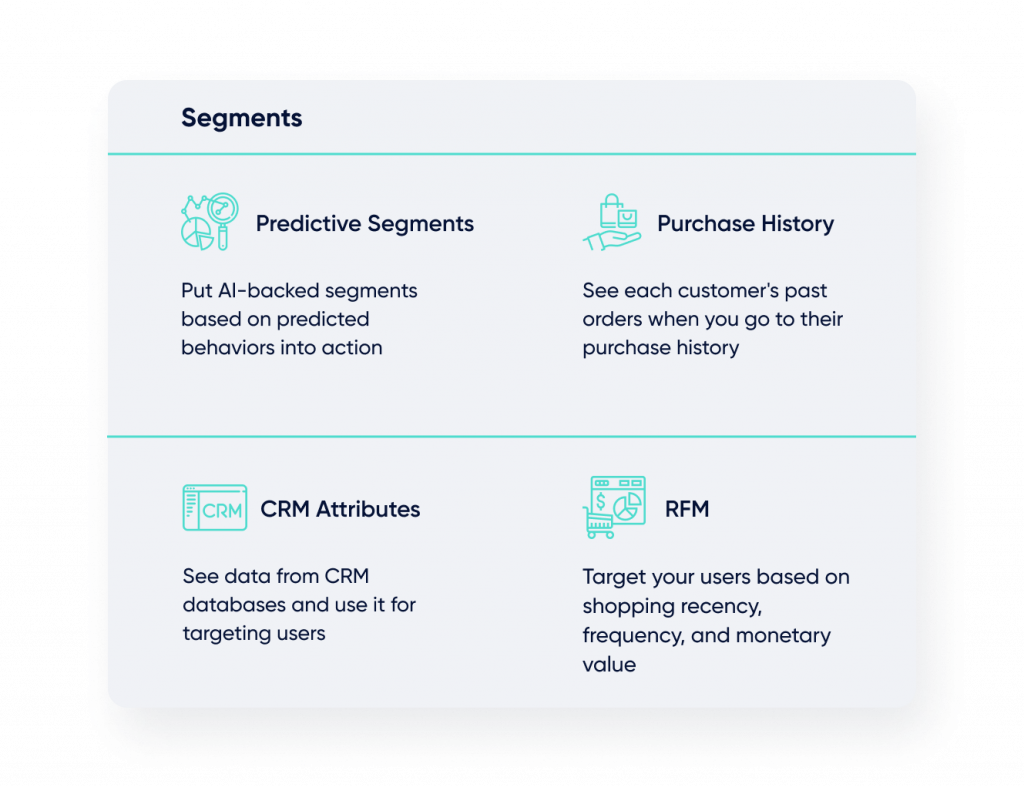What is Segmentation?
Segmentation enables you to divide your contacts or customers into dynamic groups based on shared characteristics, behaviors, or interests, allowing you to run targeted campaigns for each audience.
For example, you might create a segment for visitors who abandon carts three times in a month, then send them individualized email incentives.
What is Segmentation in Marketing?
Segmentation in marketing refers to the practice of dividing a larger target market into smaller groups or segments based on specific characteristics, traits, or behaviors.
Segmentation aims to help marketers understand and cater to the diverse needs, preferences, and behaviors of different customer groups. By tailoring marketing strategies and messages to each segment, businesses can increase the effectiveness of their campaigns and optimize their resources.
What is Market Segmentation?
Market segmentation also involves categorizing a broad market into smaller, more manageable segments. However, these segments are defined by common attributes that influence consumer behavior rather than the behaviors themself.
For instance, a brand may segment its market by age, location, or interests to offer products and strategies that resonate with each unique segment.
What is Customer Segmentation?
Customer segmentation focuses on categorizing consumers by behaviors, preferences, or characteristics. This detailed approach enables businesses to provide personalized experiences and targeted promotions.
Customer segmentation might include:
- Demographic segmentation: Dividing the market based on demographic factors such as age, gender, income, education, occupation, and family size.
- Psychographic segmentation: Categorizing customers based on lifestyle, values, attitudes, interests, and personality traits.
- Behavioral segmentation: Dividing customers based on their purchasing behaviors, usage patterns, brand loyalty, and other actions they take as consumers.
- Geographic segmentation: Segmenting the market by geographical factors such as location, climate, culture, and regional preferences.
- Occasion-based segmentation: Considering the occasions or situations when customers are likely to purchase, such as holidays or special events.

Why use Segmentation?
- Deliver more relevant content and offers by grouping audiences based on shared traits, behaviors, or preferences, driving stronger engagement and higher conversions.
- Prioritize high-value segments to allocate resources efficiently, reducing waste while focusing efforts where they’ll have the greatest impact.
- Target specific customer needs with precision, increasing loyalty and boosting sales across campaigns.
- Tailor messaging to each segment to create more relatable, meaningful interactions and foster genuine connections.
Segment Types Comparison
| Segment Type | How Dynamic? | Data Used | Use Cases/Example |
| Demographic | Static | Age, Gender, Income | Email campaign by age group |
| Behavioral | Dynamic | Activity, Purchases | Abandoned cart follow-up |
| Psychographic | Mixed | Interests, Values | Messaging by lifestyle |
| Geographic | Static | Region, Weather | Localized promotions |
| Occasion-based | Event-driven | Holidays, Events | Seasonal offers |
Frequently Asked Questions (FAQs)
Combine static and behavioural data, update dynamically, and use advanced tools for predictive segmentation. Learn more in Insider’s Market Segmentation Guide.
Behavioral segmentation identifies high-value actions, such as repeat purchases or risk of churn, allowing you to automate targeted campaigns for maximum ROI. Dive deeper into Insider’s Behavioral Segmentation Guide.
Track browsing and on-site behaviors, personalize content, and trigger sign-up incentives, even before a user is identified. See how Insider enables this in their Customer Segmentation Platform.












